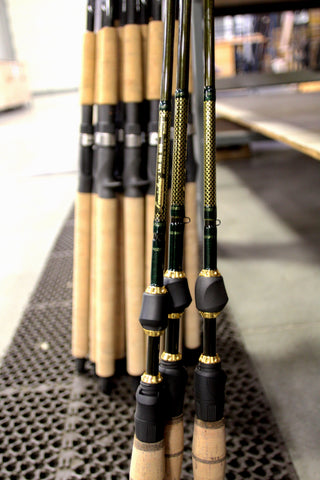Anglers talk about rod sensitivity a lot when discussing their favorite rods. It’s an attribute that rod buyers seek, some more than others. Sensitivity always seems to work its way into conversations about technique-specific rods.
What is Sensitivity?
No, it’s not a rod crying over a lost fish.
Quite simply, sensitivity is how well you can feel a bite or the bottom of the river through the rod. With some techniques, you will be amazed at how much sensitivity makes a difference. With other techniques, it will make very little difference.
Fishing rods are so diverse in how they match up to specific fisheries. One rod may work perfectly for a certain technique, while not at all for another – even while chasing the same species. Sensitivity is not always needed, but when it is – it’s essential!
What Makes a Rod Sensitive?
There is no one simple answer to this question, but there are numerous factors that play into it.
Graphite rods are widely considered the king of sensitivity as their ability to transmit vibrations to the hand is superior to other materials such as fiberglass, however, the statement below may surprise some.
If you base your rod choice just off of the material, be it “IM8″ or some other material, you are not guaranteed the most sensitive stick. How the rod blank is designed and finished will affect the sensitivity hugely.
Softer fibers require thicker walls than higher modulus would, to lift the same amount of weight. The stiffer the fiber, the less material it requires. The less material used, the easier it is for a frequency to transmit down the blank to your hand.
 A painted/coated rod blank may not feel as sensitive as the uncoated version, although you will find some coated rods that are extremely sensitive and some uncoated that are not at all. How much epoxy is coated on the guides, what reel seat you are using, what type of handle and how much glue is used will all affect sensitivity. It really is a big mixture of factors that contribute to the best overall feel. Experienced rod builders are aware of this and will choose components, blanks, and materials to optimize the fishing experience.
A painted/coated rod blank may not feel as sensitive as the uncoated version, although you will find some coated rods that are extremely sensitive and some uncoated that are not at all. How much epoxy is coated on the guides, what reel seat you are using, what type of handle and how much glue is used will all affect sensitivity. It really is a big mixture of factors that contribute to the best overall feel. Experienced rod builders are aware of this and will choose components, blanks, and materials to optimize the fishing experience.
There is a balance with seeking sensitivity, the rod must remain durable enough for the fishing it is intended for. It also must bend correctly when you’re fighting a fish. Rod makers must meet this balance by designing and using blanks that can cast the right lure and handle fish while keeping rod weight lower.
As we discussed regarding different fibers, the more material you have on a rod, the less likely it is to be sensitive. The less material you have on the rod, the less likely it is to be durable.
Many of the mass-produced, low-priced rods on the market use basic, cheap graphite that isn’t sensitive but may be quite durable. Some use solid fiberglass tips that have almost no sensitivity but will withstand major abuse.
Ultra-sensitive rods may use very light and thin blanks, but you should be careful not to hit them against rocks or branches that may compromise the blank. If a rod is designed properly and taken care of it should hold up well to fishing.
Not all graphite rods are the same and in some cases, similar rods will feel completely different. The best test is to fish it.
Choosing Gear for Sensitivity
 Fishing line is second only to the rod in gear selection to the sensitivity factor. Braided lines are very sensitive due to the zero-stretch attribute. Mono has a lot of stretch and this isn’t ideal for transmitting feel. Fluorocarbon has a lot less stretch than mono so it can be an excellent leader or mainline option. The weight of the lure you are using will play into how sensitive a rod is. If you are trying to feel the bottom with a 1/8 oz weight on a rod that is rated 4 – 8 oz., you’re going to have a much harder time. If you have too light of a rod with too heavy of a lure, it will reduce sensitivity as the rod will be bent over and much of the vibration absorbed. Matching your rod to the intended lure will give you the best result.
Fishing line is second only to the rod in gear selection to the sensitivity factor. Braided lines are very sensitive due to the zero-stretch attribute. Mono has a lot of stretch and this isn’t ideal for transmitting feel. Fluorocarbon has a lot less stretch than mono so it can be an excellent leader or mainline option. The weight of the lure you are using will play into how sensitive a rod is. If you are trying to feel the bottom with a 1/8 oz weight on a rod that is rated 4 – 8 oz., you’re going to have a much harder time. If you have too light of a rod with too heavy of a lure, it will reduce sensitivity as the rod will be bent over and much of the vibration absorbed. Matching your rod to the intended lure will give you the best result.
Techniques & Sensitivity
We mentioned techniques as they relate to sensitivity. Lamiglas has long built technique-specific rods to meet the needs of a broad range of anglers. Some rods match many techniques, others are very narrow in what they excel at.
Bass Rods
In the bass world, sensitivity is key in underwater techniques that require close attention to bottom structure and bites. Casting texas-rigged plastics as an example. As the weight and lure make contact with the bottom, being able to feel that precisely allows the angler to judge when to pick up the bait and move it. If your rod is not sensitive you won’t be able to accurately feel and keep your bait near the bottom. Largemouth bass can often pick up the bait and spit it quickly. If your rod reacts immediately to a fish acting on the bait, you are much more likely to successfully set the hook at the right time. With a “dead” tip, you may not know the difference between a bite and your bait pulling on a stick.

Some techniques may not require as much sensitivity but can benefit from it. A “crankbait” cast for bass is often best suited to rods made out of fiberglass or with composite blanks. Though sensitivity as not as essential as say, fishing with a plastic or jig, having sensitivity carry thought the rod allows you to discover cover and when your crank-bait bounces off rocks/limbs. Some anglers go with a graphite moderate or moderate/fast rod for this purpose.
Salmon & Steelhead Bank Rods
Where sensitivity is perhaps most desired in salmon and steelhead would be for drift fishing (or “bottom-bouncing.”) With this technique the angler needs to be able to feel when the weight “ticks” the bottom and most importantly when a fish bites. These bites can sometimes be extremely subtle, so dedicated anglers purchase very sensitive rods to get the most out of their drift techniques.
When float fishing, it is not as essential to have extreme sensitivity, although some anglers still benefit from it. Especially if fish are being very lethargic and not pulling the bobber under water. Some chinook do not pull the bobber underwater but instead just stop it or tilt the float, sometimes the angler can feel that and set the hook based on what they feel through the rod. Float fishermen are not as concerned about sensitivity as drift fishermen though, as it is mostly about the visuals and having a light enough rod to fish all day.
For back-bouncing, hover fishing or similar techniques, sensitivity cannot be understated. Since bottom connection and light bites are involved, you need to be able to immediately react to the bite. Rods still need backbone so it is a delicate balance of power and sensitivity.
Trolling Rods
With techniques like trolling, down-rigger or plug-pulling, sensitivity is not a factor in hooking fish as the rod is in the rod holder when the fish bites. More important is viewing the action of the tip. However, a sensitive tip while trolling can be very helpful when letting down your weight. If you are dropping a heavy weight to the bottom, feeling your weight hit the bottom gives you an instant indication of when to stop spooling line out.

Walleye Rods
When jigging for walleye, the bites can be very light and extremely subtle. The walleye rod you use should be a faster action that responds quickly to the bite, but so sensitive that you can feel every movement and change in pressure on the jig. Sensitive walleye jigging rods are extremely sought after.
Saltwater Inshore Rods
Inshore rods can span a wide range of powers. For the lighter inshore rods, sensitivity is easier to achieve due to the lighter blanks and graphite construction. These are similar to bass rods in their length and sensitivity. Once you get into large inshore species you must able to operate heavy weights while retaining a tip that translates lighter bites. Lamiglas rods are very popular for their ability to powerfully handle fish but also feel changes in resistance in the tip.
Surf Rods
Surf anglers often fish longer, stouter rods to achieve great casting distance into the surf, however, they still require a high degree of sensitivity. When retrieving a plug or a bucktail jig, feeling exactly how your presentation is reacting and moving is essential to entice more bites. Anglers who do not fish surf rods may be surprised at how much you can feel through the rod, although they are longer and stouter than many other rod types.
Optimize
Getting a rod that fully translates sensitivity to the hand is going to depend on choosing the best rod for your species and technique. If you choose a quality rod wisely based on lure and line rating and designed for your technique, you will get the most out of your gear. Don’t settle for “dead” feeling rods when the technique demands a sensitive feel. You will maximize your bites and hook more fish.
Once you get the fish hooked…well, it’s all up to you!
Lamiglas has some of the most sensitive, strong and fishable rods on the market today.



